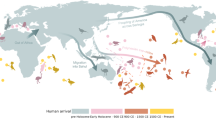Abstract
During their colonization by Polynesians and later by Europeans, the Hawaiian islands suffered a massive loss of species. All the extinctions are indirectly attributable to human impact. Nonetheless, it has proved extremely difficult to specify which of several possible mechanisms caused each particular extinction. This seems to admit defeat in the battle to understand past extinctions. Such understanding could guide our efforts to protect species that are now threatened with extinction. Will it be easier to understand the causes of future extinctions? Surveys of future extinctions stress habitat destruction as the simple and dominant mechanism. This contrasts to its secondary (and generally confused) role in past extinctions. I argue that this contrast between the complexity of the past and the apparent simplicity of the future arises because extinction mechanisms are inherently synergistic. Once extensive species losses begin, it may be impossible to separate the mechanisms and thus manage an individual species as if its decline had a single cause.
Similar content being viewed by others
References
Brooks, T.M., Pimm, S.L. and Collar, N.J. (in press) Tropical deforestation predicts future extinctions in insular south-east Asia. Conserv. Biol.
Collar, N.J., Crosby, M.J. and Stattersfield, A.J. (1994) Birds To Watch 2: The World List of Threatened Birds. Cambridge: BirdLife International.
Daws, G. (1968) Shoal of Time. Honolulu: University of Hawai'i Press.
Diamond, J.M. (1984a) Historic extinctions: a rosetta stone for understanding prehistoric extinctions. In Quarternary Extinctions: a Prehistoric Revolution (P.S., Martin and R.G., Klein, eds) pp. 824–62. Tucson: University of Arizona Press.
Diamond, J.M. (1984b) ‘Normal’ extinctions of isolated populations. In Extinctions. (M.H., Nitecki, ed.) pp. 191–246. Chicago: University of Chicago Press.
Grant, P.R. (1995) Commemorating extinctions Am. Sc. 83, 420–22.
Hadfield, M.G. (1986) Extinction in Hawaiian achatinelline snails. Malacologia 27, 67–81.
Jaffe, M. (1994) And No Birds Sing. New York: Simon and Schuster.
James, H.F. and Olson, S.L. (1991) Descriptions of thirty-two new species of birds from the Hawaiian islands: Part II. Passeriformes. Ornithological Monographs 46. Washington, DC: American Ornithologists' Union.
Kirch, P.V. (1994) The Wet and the Dry. Chicago: University of Chicago Press.
Milberg, P. and Tyrberg, T. (1993) Naive birds and noble savages — a review of man-caused prehistoric extinctions of island birds. Ecography 16, 229–50.
Moulton, M.P. and Lockwood, J.L. (1992) Morphological dispersion of introduced Hawaiian finches: evidence for competition and a Narcissus effect. Evol. Ecol. 6, 45–55.
Moulton, M.P. and Pimm, S.L. (1985) The extent of competion in shaping an experimental avifauna. In Community Ecology (J., Diamond and T., Case, eds) pp. 80–97. New York: Harper and Row.
Moulton, M.P. and Pimm, S.L. (1987) Morphological assortment in introduced Hawaiian passerines. Evol. Ecol. 1, 113–24.
Myers, N. (1988) Threatened biotas: ‘hot spots’ in tropical forests. Environmentalist 8, 187–208.
Myers, N. (1990) The biodiversity challenge: expanded hot-spots analysis. Environmentalist 10, 243–56.
Nott, P., Rogers, E. and Pimm, S.L. (1995) Modern extinctions in the kilo-death range. Curr. Biol. 5, 14–17.
National Research, Council (1992) The Scientific Bases for the Preservation of the Hawaiian Crow. Washington, DC: National Academy Press.
Olson, S.L. and James, H.F. (1982) Fossil birds from the Hawaiian Islands: evidence for wholesale extinction by man before western contact. Science 217, 633–5.
Olson, S.L. and James, H.F. (1991) Descriptions of thirty-two new species of birds from the Hawaiian islands: Part I. Non-Passeriformes. Ornithological Monographs 45. Washington, DC: American Ornithologists' Union.
Pimm, S.L. (1991) The balance of nature? Ecological Issues in the Conservation of Species and Communities. University of Chicago Press, IL: Chicago.
Pimm, S.L. and Askins, R. (1995) Forest losses predict bird extinctions in eastern North America. Proceedings of the National Academy of Sciences of the USA 92, 9343–7.
Pimm, S.L., Moulton, M.P. and Justice, J. (1994) Bird extinctions in the central Pacific. Phil. Trans. Roy. Soc. B: 344, 27–33.
Pimm, S.L., Russell, G.J., Gittleman, J.L. and Brooks, T.M. (1995) The future of biodiversity. Science 269, 347–50.
Robinson, S.K., Thompson, F.R.III, Donovan, T.M., Whitehead, D.R. and Faaborg, J. (1995) Regional forest fragmentation and the nesting success of migratory birds. Science 267. 1987–90.
Rose, R., Conant, S. and Kjellgren, E. (1993) Hawaiian standing kahili in the Bishop Museum: an ethnological analysis. The Journal of the Polynesian Society 102, 273–304.
Skole, D. and Tucker, C. (1993) Tropical deforestation and habitat fragmentation in the Amazon: satellite data from 1978 to 1988. Science 260, 1905–10.
Scott, J.M., Mountainspring, S., Ramsey, F.L. and Kepler, C.B. (1986) Forest Bird Communities on the Hawaiian Islands: their Dynamics, Ecology and Conservation. Berkely, CA: Cooper Ornithological Society.
Smith, T.B., Freed, L.A., Lepson, J.K. and Carothers, J.H. (1995) Evolutionary consequences of extinctions in populations of a Hawaiian Honeycreeper. Conserv. Biol. 9, 107–13.
Sohmer, S. (1994) Conservation and the Manual of the Flowering Plants of Hawai'i: a sense of reality or nine easy steps to producing a relevant flora. In Biodiversity and Terrestrial Ecosystems. (C.-I. Peng and C.H. Chou, eds) pp. 43–51. Taipei: Academia Sinica Monograph Series 14.
Steadman, D.W. (1995) Prehistoric extinctions of Pacific Island birds: biodiversity meets zooarchaeology. Science 267, 1123–31.
Wagner, W.L., Herbst, D.R. and Sohmer, S.H. (1990) Manual of the Flowering Plants of Hawai'i. 2 Volumes. Bishop Museum Special Publication 83. Honolulu: University of Hawai'i Press.
World Conservation Monitoring Centre (1992) Global Biodiversity: Status of the Earth's Living Resources. London: Chapman & Hall.
Author information
Authors and Affiliations
Rights and permissions
About this article
Cite this article
Pimm, S.L. Lessons from a kill. Biodivers Conserv 5, 1059–1067 (1996). https://doi.org/10.1007/BF00052716
Received:
Revised:
Accepted:
Issue Date:
DOI: https://doi.org/10.1007/BF00052716




